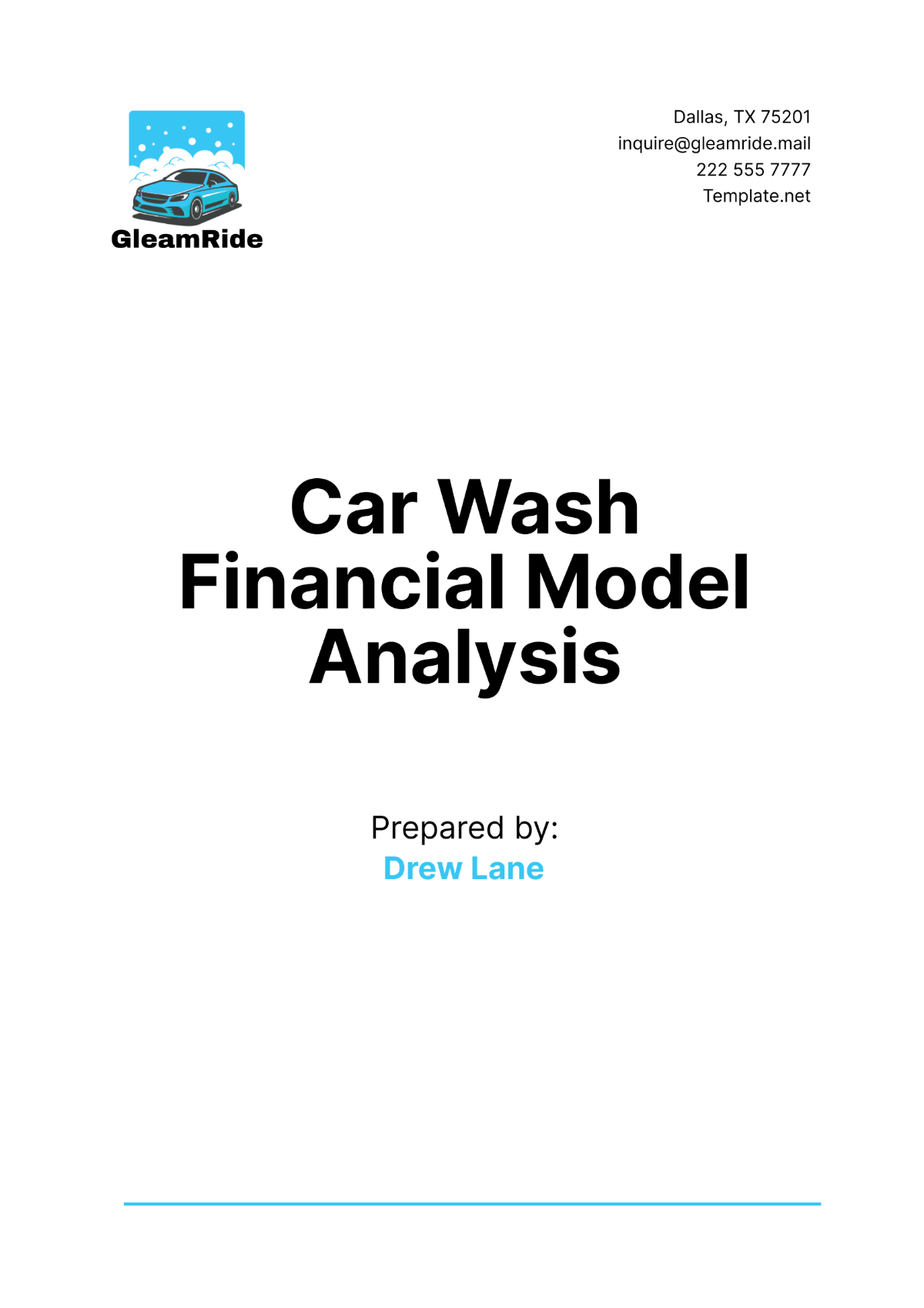Free Car Wash Financial Model Analysis

I. Introduction
This document provides an in-depth financial model analysis for [Your Company Name], offering a comprehensive evaluation of the car wash business’s financial health and growth potential. Our financial model meticulously examines revenue projections, cost structures, and profitability metrics, designed to support strategic decision-making and drive business success. By analyzing various financial components, including initial investments, operational expenses, and revenue streams, this report offers a clear picture of the car wash business's economic viability and future prospects.
Our approach includes a detailed market analysis to identify growth opportunities, a breakdown of revenue streams to explore potential income sources, and a thorough cost analysis to ensure efficient resource allocation. We also provide insights into cash flow management, break-even analysis, and long-term financial projections to forecast future performance and investment returns. This financial model is intended for use by stakeholders, investors, and management teams to make informed decisions about the direction and development of [Your Company Name]. By understanding the financial dynamics of the car wash business, we aim to optimize operations, maximize profitability, and achieve sustainable growth.
II. Revenue Projections
The revenue projections for a car wash business are influenced by several key factors including service pricing, customer volume, and upselling opportunities.
Pricing Structure
Basic Wash: $10
Deluxe Wash: $20
Premium Wash: $30
Customer Volume
Average Daily Customers: 100
Peak Season Adjustments: +20%
Additional Services
Interior Cleaning: $15
Waxing: $25
III. Cost Considerations
Understanding cost dynamics is crucial for evaluating the financial health and sustainability of [Your Company Name]’s car wash business. By breaking down and analyzing both fixed and variable costs, we can gain insights into the operational expenses that impact profitability. This section delves into the various cost elements associated with running a car wash, highlighting how these expenses contribute to the overall financial structure of the business.
We have categorized costs into two main types: fixed costs, which remain constant regardless of the volume of services provided, and variable costs, which fluctuate based on business activity. The following table outlines the key monthly expenses for [Your Company Name], providing a detailed overview of the primary cost components involved in maintaining and growing the car wash business.
Cost Type | Monthly Cost |
|---|---|
Rent | $2,000 |
Employee Salaries | $8,000 |
Utilities | $1,500 |
Supplies | $1,000 |
Marketing | $500 |
IV. Profitability Metrics
Analyzing profitability metrics is essential for understanding the financial performance and success of [Your Company Name]’s car wash business. This section covers key financial ratios and analyses that reveal how well the business is performing in terms of profit generation and cost management. By evaluating metrics such as Gross Profit Margin, Net Profit Margin, and Break-even Analysis, we can gain insights into the efficiency of operations and the overall financial health of the car wash.
These metrics not only help in assessing current profitability but also serve as benchmarks for future financial planning. The following subsections detail each metric, providing calculations and explanations to support strategic decisions aimed at maximizing profitability and ensuring long-term success.
A. Gross Profit Margin
The Gross Profit Margin measures how effectively [Your Company Name] converts revenue into profit, excluding operational expenses.
Gross Profit Margin: (Revenue - COGS) / Revenue) * 100 = 62.5%
Revenue (Monthly) | COGS |
|---|---|
$40,000 | $15,000 |
B. Net Profit Margin
The Net Profit Margin reflects the percentage of revenue that remains as profit after accounting for all operating expenses and costs.
Net Profit Margin: (Revenue - Total Operating Expenses) / Revenue) * 100 = 67.5%
Total Operating Expenses: | $13,000 |
C. Break-even Analysis
Break-even Analysis determines the sales volume required for [Your Company Name] to cover all fixed and variable costs, indicating when the business will start to generate profit.
Break-even Volume: Fixed Costs / (Price per Car - Variable Cost per Car) = 750 cars
Fixed Costs | Variable Cost per Car |
|---|---|
$15,000 | $3 |
V. Conclusion
This financial model analysis underscores the critical balance between revenue management and cost control for ensuring profitability in [Your Company Name]’s car wash business. By thoroughly examining revenue streams, cost structures, and key financial metrics, we have identified that achieving profitability requires not only effective pricing strategies but also meticulous cost management. Strategic pricing, which aligns with market conditions and customer expectations, plays a pivotal role in maximizing revenue. At the same time, managing both fixed and variable costs is essential to maintaining a healthy profit margin.
Efficient cost management involves a comprehensive understanding of expenses such as rent, salaries, utilities, supplies, and marketing. By controlling these costs without compromising service quality, [Your Company Name] can enhance its financial performance. The cost breakdown provided in this analysis illustrates the key expenditure areas and highlights opportunities for optimization. Regularly reviewing these expenses and identifying potential savings will be crucial for sustaining profitability and supporting growth.
Continuous monitoring of financial metrics, including Gross Profit Margin, Net Profit Margin, and the Break-even Analysis, is vital for long-term success. These metrics provide valuable insights into the effectiveness of current strategies and help in making informed decisions for future planning. By focusing on strategic pricing, efficient cost management, and diligent financial analysis, [Your Company Name] can navigate challenges, seize opportunities, and achieve sustained success in the competitive car wash industry.
- 100% Customizable, free editor
- Access 1 Million+ Templates, photo’s & graphics
- Download or share as a template
- Click and replace photos, graphics, text, backgrounds
- Resize, crop, AI write & more
- Access advanced editor
Achieve financial clarity with the Car Wash Financial Model Analysis Template from Template.net. This fully customizable and editable template is perfect for analyzing your car wash's financial performance. Easily editable in our Ai Editor Tool, you can tailor it to your specific needs, ensuring a comprehensive and professional financial analysis.





























